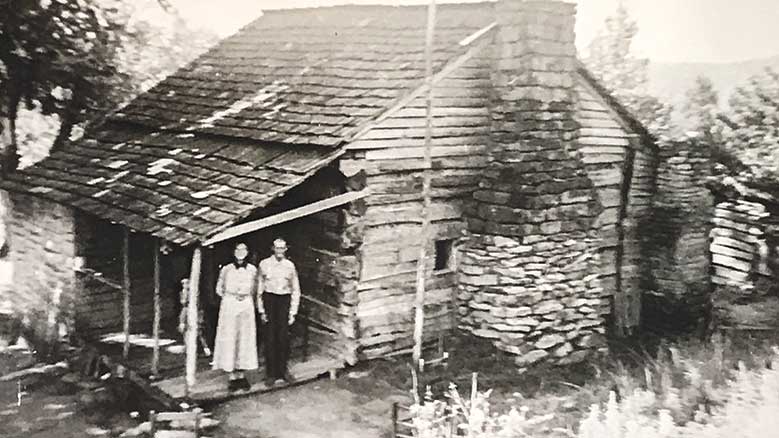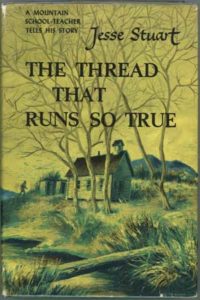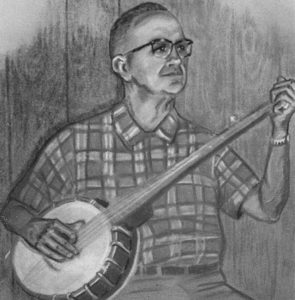
I went through a phase when I wanted to be a tribute artist, portraying a famous author in various classrooms in the area—or even across the country. Being six foot two, two hundred plus pounds, half-Kentuckian, and a former classroom teacher, the author I had in mind was one of my favorites: Jesse Stuart.
 He wrote The Thread That Runs So True, published in 1949 as an autobiographical look at his experience as a school teacher in the hills of Kentucky. I read it in ninth grade and wrote a book report on it. In fewer than 200 words, I panned the book. I wrote that Stuart had put too much emphasis on the “outdoor life” in Kentucky and that he had written too much about “teachers’ salaries” and “school finance troubles.” Even though my naive 15-year-old self was less-than-impressed with The Thread That Runs So True, as often happens in the public school classroom, something clicked.
He wrote The Thread That Runs So True, published in 1949 as an autobiographical look at his experience as a school teacher in the hills of Kentucky. I read it in ninth grade and wrote a book report on it. In fewer than 200 words, I panned the book. I wrote that Stuart had put too much emphasis on the “outdoor life” in Kentucky and that he had written too much about “teachers’ salaries” and “school finance troubles.” Even though my naive 15-year-old self was less-than-impressed with The Thread That Runs So True, as often happens in the public school classroom, something clicked.
Maybe it was the Kentucky perspective. My dad came from Kentucky and my mom was a Hoosier. Possibly Stuart’s artful descriptions of the Kentucky landscape and its people tapped into the Kentucky part of my DNA. My teacher, Mrs. Rickert, noticed that I started imitating Stuart’s writing style in later composition assignments, ironically incorporating lavish descriptions of nature. Mrs. Rickert even gave us an assignment to describe a famous guest visiting our homes and I chose—who else?—Jesse Stuart.
A year or two later, another English class read Stuart’s “Split Cherry Tree,” a short story in our literature anthology. Again, some mysterious power allowed Stuart to touch my roots. I could picture the old man in the story, coming to school armed and ready to withdraw his son, examining scrapings from his own teeth as he peered through the new-fangled microscope, and the science teacher convincing him to let the son stay.
It wasn’t elaborate natural description or teachers’ salaries this time. It was human-to-human relationships and the message that it is difficult to dwell in the past and still keep pace with today’s world. No doubt, a little seed for a career in teaching was planted then.
Stuart honestly describes the people in his works, both in his fiction and in his non-fiction, and gives them dignity. You feel their hearts beat; you sense the blood pulsing through their veins; and you know the synapses are working in their brains. A Kentuckian spirit is present that I am proud to also possess.
Reading Stuart in my youth, I was easily captivated by the purity and the innocence. The Thread That Runs So True has little to no profanity, maybe a mild swear word here or there. Violence is usually limited to hunting squirrels or rabbits. The most violent scene in the book is the fist fight Stuart has with the giant young man who is still a first-grader but who is determined to drive him from the school. Stuart recounts that experience in detail. It is an important scene because he is just as determined to remain, and the moment is a turning point in their relationship and for Stuart’s reputation among the hill folk.
Kentucky hill folk are stereotyped, especially in Indiana. “Toothless,” “stupid,” “lazy,” “mean”—just about any disparaging description lends itself to insensitive remarks or cruel jokes. Their positive values, such as family bonds, loyalty, work ethic, and integrity, are frequently overlooked. A recent bestseller, J.D. Vance’s Hillbilly Elegy, explained how the migrations from Appalachia brought hillbilly values northward to Ohio and Indiana. For many Hoosiers, it was hard to be accepting and understanding of the Kentuckian subculture. But that is another element I like about The Thread That Runs So True. Stuart honestly describes the people in his works, both in his fiction and in his non-fiction, and gives them dignity. You feel their hearts beat; you sense the blood pulsing through their veins; and you know the synapses are working in their brains. A Kentuckian spirit is present that I am proud to also possess.
The Thread That Runs So True is Stuart’s account of his life as an educator. When I read it in ninth grade, a future teaching career was not even an option. I had already spent eight years in school, and, though I was comfortable in classrooms, my dreams had to do with writing and art. In fact, for a career project as a high school freshman, I chose to be an industrial designer, attending the University of Cincinnati and designing toasters. Stuart did not reveal to me that I, too, could be a successful teacher.
Maybe reading The Thread That Runs So True did plant the idea that got nurtured ever-so-slowly during my high school career. By the time I was ready to graduate, I had plans to attend Ball State Teachers College in Muncie, Indiana.
After graduating from Ball State, I taught high school English for over three decades. I tried to inspire my students, to encourage them, to get them to have higher expectations for themselves, to help them learn and achieve. I wanted them to look forward to coming to my class and to enjoy the challenges of learning there. My room was “the marketplace of ideas.” We strove to be better writers by the end of the year than we were at the beginning. We explored a wide variety of subjects through literature and discussion. My outside reading list, which consisted of many classics, also included Stuart works, such as The Thread That Runs So True, along with Taps for Private Tussie, Hie to the Hunters, and Daughter of the Legend. Those books by Stuart continued to resonate with students years after my own introduction to the author. Yes, I agreed with Stuart, who wrote this in The Thread That Runs So True about teachers:
I thought if every teacher in every school in America—rural, village, city, township, church, public, or private, could inspire his pupils with all the power he had, if he could teach them as they had never been taught before to live, to work, to play, and to share, if he could put ambition into their brains and hearts, that would be a great way to make a generation of the greatest citizenry America ever had.

In later years, when I discovered Stuart’s poetry, I gained an even greater appreciation for the lyrical quality of his prose. As a more mature reader, I marveled at those “outdoor life” descriptions in The Thread That Runs So True that had escaped me at age 15, such as this one:
I looked to my left and to my right for an opening of light; of golden moonlight upon the open fields, upon the patches of ripening wheat and oats, broad leafed, lusty, green-growing tobacco, and the dark clouds of stalwart corn.
The imagery. The simplicity. The sense of place. Again, this may have been a genetic response, because I’m sure that my less-poetic father and his Kentuckian ancestors had similar feelings about the beauty of Kentucky’s hills and “hollers.”

Stuart died in 1984. The New York Times reported that his funeral service was to be at a Methodist church in his hometown. I realized then that I was unaware of any religious denomination he had identified with. He could have been a Quaker since his stories emphasize simplicity and seeing that of God in everyone; also, his characters have integrity, a sense of community, and respect for the environment. Nevertheless, it did not affect my respect for Stuart and his literary legacy.
I wanted to accumulate his books for my personal library. Luckily, a lady in my hometown advertised in our newspaper that she had a couple of Jesse Stuart books for sale. When I went to check on their condition and price, I found that they were in poor condition and that she wanted an outrageous amount of money for them. Not only that, she had not read the books and really didn’t know who Stuart was—just that he had recently died and that now his books would be collectible. Discouraged, I thought I would never gather my small library of Stuart works. But over the years, I found old, discarded copies at public library book sales and new reprinted versions in the gift shop of a Kentucky state park. My library is not yet complete, but it is getting there.
So, I am a Hoosier and I am a Quaker. Stuart is neither. However, somehow he has spoken to me. Sometimes it has even felt like a spiritual encounter. My introduction to Jesse Stuart and The Thread That Runs So True years ago in a ninth-grade English class changed me and revealed facets of my character that might have remained dormant had it not been for that reading experience. Although I am not a Kentuckian, I am confident I could portray one in someone else’s classroom because I now identify with what Stuart said in his poem “Kentucky Is My Land”:
I take with me Kentucky embedded in my brain and heart,
In my flesh and bone and blood
Since I am of Kentucky
And Kentucky is part of me.



It always touches my heart to read about being personally affected feeling a bond with author of a book. I read Jane Eyre
by Charlotte Bronte…realized I had never read it as a young person) I am 89. It was almost an uneasy feeling. I always knew and felt deeply whenever this happened. I forget most of the novels…but I will never forget Jane Ayre.
Thanks for sharing your story. Best wishes…Joan Kindler
I wasn’t born a Quaker but when I found my first meeting I felt instantly at home. Perhaps as “Quaker” is so frequently synonimous basic decency and compassion and not historical guidelines, we are getting to a point beyond labels. Who knows?
I grew up a short distance from Stuart’s W-Hollow. As a youth I was a prolific reader but Stuart didn’t appeal to me because he seemed to chain my area to the past and the backward. I also grew up in the TV era and I wanted to be a part of the modern world I saw there. I felt Stuart was part of a dying culture even though in truth it was still very much alive around me and in fact I was part of it. I really didn’t understand how much that was true until I moved to Indianapolis for a few years starting around 1980. It was true that people there ridiculed us hill folk. It caused no small amount of friction with some residents of that region. But there was also an element that respected the hill culture largely because many were connected to that culture themselves.
I had not read Stuart’s books as a child because I knew his reputation and wanted to be something else as many young people do. When I did start reading his books as an adult I was amazed at the sheer talent he had for captivating readers in his world. I had gone so far as to tell his niece once that I didn’t like him because he made us all look like backwards hillbillies. But the truth was we were hillbillies and could not and should not be different. Stuart inspired me with The Thread That Runs So True. He entertained me with Taps For Private Tussie. And he described me in Hie To The Hunters. I was not a “townie”. I grew up living close to the land and although many aspects of my life were different from the hill people of Hie To The Hunters I shared a lot with them. And I actually felt sad that modern life was changing the almost eternal culture that existed there before.
I have my own collection of Stuart’s books now. Some are autographed and some are first editions. I read a digital version of Hie To The Hunters first and I fell in love with that book so I wanted a hard copy. To my amazement the prices were ridiculously high everywhere I found it. The lowest prices I saw were around $500. There was a low supply and a high demand. Thankfully the Jesse Stuart Foundation printed a new edition and I got one at a reasonable price.
Stuart has become a mythic figure locally even though at one point a lot of people shared my disdain for his portrayal of our area as backward. His writings especially those in a local newspaper created many enemies for him locally. Fortunately that has completely ended and people respect him for the towering figure he was.
He was a man of his time and I was wrong to judge him by later standards. He was a treasure of the community for his role as ambassador to the world for our people among many other things. His works continue to inspire and entertain. He is among the greatest authors this country has produced in my opinion. Many share that opinion around the country. He was once as well known as any American author but time has a way of making people forget. I think his works will stand the test of time though and they will be seen by future generations as the work of a great American author who happened to live less than five miles from where I grew up.